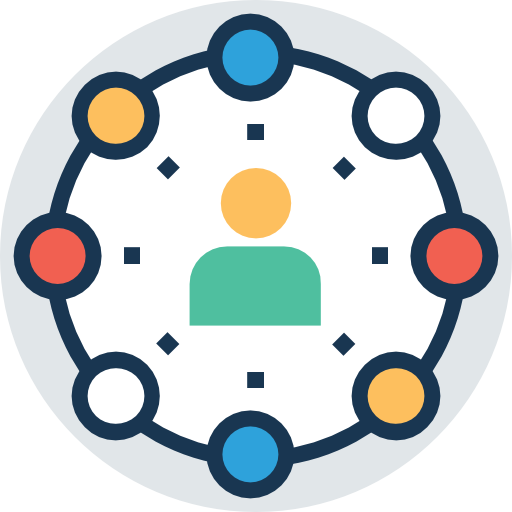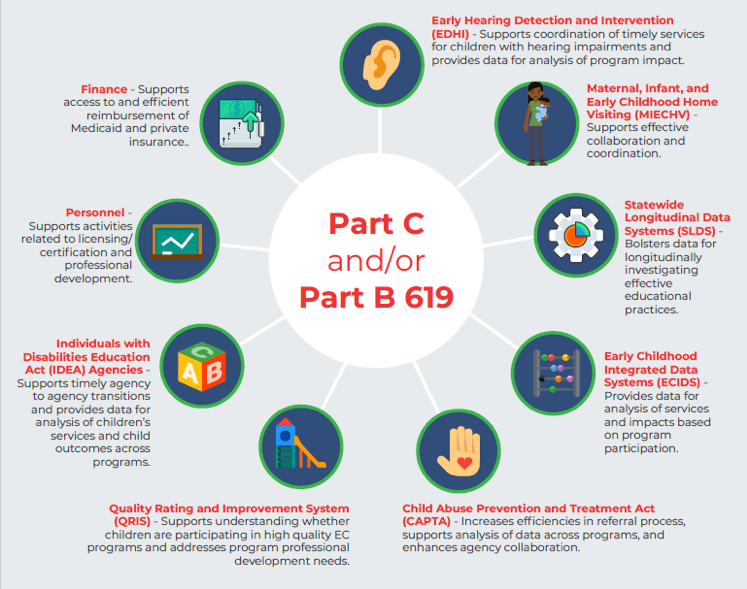Part One in our Data Linking Blog Series
Authors: Bruce Bull and Denise Mauzy

There is no requirement for Part C or Part B 619 programs to link data with other programs, but some states do. Given the extra time and effort it takes, why do some programs pursue data linking? The ultimate goal of data linking is to better support children and families. Having linked data can help with program operations, resulting in administrative efficiencies. Data linking also provides programs access to more data to answer questions that can inform and support quality improvement efforts. Plus, because only existing information is linked, no extra effort or resources are expended to collect additional data.
So, what does data linking look like? The answer is, “It depends.” Data linking may occur within a single program within an agency linking two or more program datasets (e.g., SEA links vendor-provided child outcome data with child service delivery data). Or it may involve multiple programs within a single agency (e.g., the Department of Health connects hearing assessment data with early intervention data). Data linking also includes linking data from multiple programs across multiple agencies (e.g., two agencies link Part C data to Part B 619 to support transition notification). Data linking events can be temporary, routinely scheduled, ongoing, or constant. (Constant linking is often considered data integration, a specific type of data linking.)
The purpose for linking will dictate the level of and type of data joined. If the purpose is to improve administrative efficiencies between partnering programs, detailed information is shared (sometimes in real time) and used to perform administrative tasks (e.g., transition notification, eligibility determination). If the purpose of the data linking is to improve programs, information (often deidentified) is shared and analyzed to yield answers to program improvement questions (e.g., compare outcome scores of exiting 619 children who received early intervention services to outcome scores of exiting 619 children who did not).
Part C and Part B 619 programs have many potential data linking partners to implement administrative efficiencies and program improvements —ultimately to better serve children and families—as shown in the figure below.

Let’s review the benefits two agencies in Alaska experienced as a result of linking their child welfare data with their Part C data.
Child Abuse and Prevention and Treatment Act – Child Welfare and Part C lead agencies are required to develop and implement policies and procedures for referring children with substantiated cases of maltreatment to state Part C Early Intervention programs. By linking Child Welfare and Part C data, Alaska was able to automate the referral process. Specifically, Alaska experienced these program operational efficiencies:
- more maltreated children receiving Part C services;
- better coordination between Child Welfare and Part C staffs;
- higher data quality by having current family contact information and less record duplication;
- reduced Child Welfare and Part C workloads from less data entry of incorrect contact information; and
- improved Child Welfare substantiation timeline compliance.
These agencies also were better able to answer additional program improvement questions. For more information about Alaska’s approach and process for data linking, please see the Alaska State Spotlight: Alaska: Improving Referrals of Victims of Maltreatment to the IDEA Part C Program.
This is just one example of the data linking partnerships Part C and Part B 619 programs may pursue. What operational efficiencies could your program realize through a data linking partnership? Have you identified questions you want to answer but realize you need data from other partners to do so? If yes, you may be ready to consider a data linking partnership.
Read Part Two of our Data Linking Blog Series: Five Considerations for Potential Data Linking Partners.
If you have any questions regarding data linking and/or need support to plan a data linking partnership, please contact DaSy.
About the Authors

Bruce Bull is a DaSy TA provider. He has worked directly in the IDEA data world since 1996 as a state Part B and Part C data manager, developer of data collection systems, and as a TA provider with six OSEP-funded TA Centers.

Denise Mauzy is a DaSy TA provider. She designs and delivers technical assistance on early childhood, child and family services, data governance and management, and data systems. She has worked extensively with education and human service program staff on the development of data governance and management policies and procedures, including data linking.
Published September, 2019.


